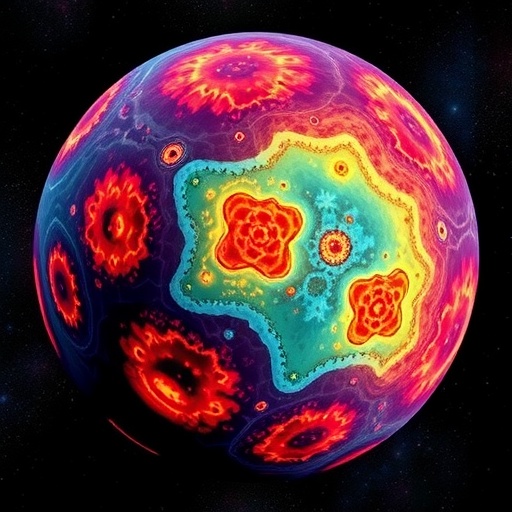A groundbreaking study undertaken by a collaborative research team has transformed our understanding of the upper mantle’s structure, yielding significant insights into its heterogeneity. The joint effort included Senior Research Scientist Shiki Machida from the Next-Generation Marine Resources Research Center at Chiba Institute of Technology, alongside Professor Kyoko Okino from the Atmosphere and Ocean Research Institute at the University of Tokyo, as well as expert researchers from the Graduate School of Engineering and the National Museum of Nature and Science. Their findings derive from meticulous physical evidence and chemical analyses of volcanic materials sourced from the Central Indian Ridge.
At the heart of this research is the concept of “heterogeneity” within the Earth’s upper mantle. Traditionally, the conceptual framework has suggested that this heterogeneity existed at scales exceeding 100 kilometers based on seismic data. However, through comprehensive analysis, the research team has conclusively determined that the true spatial scale of this heterogeneity is, in fact, under 10 kilometers. This revelation positions the upper mantle as a much more dynamic entity than previously posited.
The study particularly focused on the influences of large-scale geological phenomena known as mantle plumes. These plumes, originating deep within the Earth, transport recycled materials—such as ancient rocks once part of the Earth’s surface—directly into the upper mantle. The researchers utilized detailed chemical experiments on volcanic lavas to affirm that these plumes facilitate a much faster mixing and homogenization of materials than earlier studies had indicated. The significance of this lies in the way it challenges former beliefs about the temporal and spatial behaviors of geological materials within the Earth’s interior.
In terms of methodology, the researchers employed observational strategies that informed their understanding of how material flows and interacts in the upper mantle. By examining the compositional changes of lavas as they were displaced along the mid-ocean ridge, the team reached a pivotal conclusion about the spatial characteristics of heterogeneity. This innovative approach not only offered clarity on the scale of heterogeneity but also provided insights into the mechanisms involved in the recycling processes that characterize Earth’s geodynamics.
The implications of these findings extend far beyond geological theorization; they hint at a more intricate biological metaphor of Earth’s interior. The authors of the study propose that the mixing processes within the upper mantle can be likened to a form of “metabolism.” Just as living organisms continuously cycle nutrients and materials within their systems, so too does the Earth exhibit similar behaviors beneath its crust, emphasizing a dynamic interplay between various geologic processes.
An important aspect of the findings is the challenge it poses to the long-standing models that have governed our understanding of the Earth’s internal structure. Researchers previously believed that the upper mantle behaved like a static layer, characterized by slow movements. However, this new research highlights a relatively rapid homogenization which could reshape future understandings of tectonic plate interactions and volcanic activity.
In the backdrop of this research is an intricate balance between tectonic activities, volcanic eruptions, and the material properties of the mantle. As mantle plumes incite the rise of material from the depths of Earth’s interior, the accompanying mixing processes create not just chemical changes but also shifts in thermal dynamics in regions such as the Central Indian Ridge. This points to a far more intricate relationship between surface phenomena and deep-Earth processes.
Moreover, understanding the spatial scale of heterogeneities aids in comprehending the thermal history of the mantle. Variations in temperature and composition help inform models of mantle convection and the behavior of tectonic plates. The significance of chemical recycling routes from the surface to the mantle sheds light on the Earth’s evolutionary history, offering clues about past climatic and atmospheric conditions.
By establishing a narrower range for the scale of upper mantle heterogeneity, the researchers also opened pathways for future studies. One of the next steps could involve utilizing advanced seismic wave technology to further explore these depths with the enhanced understanding now in hand. Such techniques could lead to even more refined models and greater comprehension of earth processes.
As researchers dive deeper into this realm of mantle dynamics, interdisciplinary collaborations may yield significant breakthroughs. Integrating the insights from geology, geochemistry, and geophysics will help create more comprehensive models that could eventually unravel the complexities of Earth’s inner workings. This collaborative spirit mirrors the geological processes themselves—an ongoing cycle of contribution, transformation, and renewal.
In summary, the findings from this study remind us that despite advancements in geological science, there remains much to discover about our planet’s depths. The less than 10-kilometer scale puts forth an intriguing narrative of rapid geological change, challenging our perceptions and urging a reevaluation of established concepts. This newfound knowledge not only enriches our understanding of Earth’s dynamics but also heralds a new chapter in earth science, inviting curiosity and exploration into the depths of our planet.
Subject of Research:
Article Title:
News Publication Date:
Web References:
References:
Image Credits:




